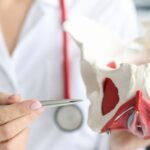In knee arthroscopy surgery, an arthroscope—a tiny instrument— is used by a surgeon to examine and repair damaged tissue. It is a less disturbing form of surgery to identify and address joint problems.
A camera on the arthroscope enables medical professionals to look for damage to the joint. Arthroscopy has certain benefits over more invasive operations because it only requires small skin incisions. Because knee arthroscopy surgery often needs shorter recovery times, it has become more popular. Serious problems are rare, and the treatment usually takes less than an hour. In this blog, we will cover all facts related to knee arthroscopy and get insights from a surgeon who is an expert knee replacement doctor in Dwarka.
What is knee arthroscopy?
An arthroscope is a special telescope used in knee arthroscopic procedures. It is inserted into your knee via a tiny incision known as “key-hole” surgery.
The interior of your knee is carefully examined with the digital camera that the arthroscope uses. Any required operations (such as repairing damaged cartilage or reconstructing a ligament) are completed at this time by making separate, tiny incisions.
Why need knee arthroscopy?
Knee arthroscopy is known to treat a variety of knee-related conditions. The following are some typical causes for which a knee arthroscopy could be recommended:
- Identifying knee problems: One method for determining the source of unexplained knee discomfort, swelling, or dysfunction is knee arthroscopy. An accurate diagnosis is made by the surgeon’s ability to directly view the menisci, ligaments, and cartilage inside the knee joint thanks to the arthroscope.
- Meniscus tears: Common knee injuries such as meniscal tears can result in discomfort, oedema, and restricted motion. With knee arthroscopy, doctors can remove or mend damaged meniscal tissue, improving knee function and reducing related pain.
- Repair of injured ligament: Trauma or sports-related activities can result in injuries to the collateral ligaments and cruciate ligaments (PCL and ACL). Knee arthroscopy can be used to rebuild or repair injured ligaments, giving the knee joint stability again.
- Repair of damaged cartilage: Cartilage injuries or abnormalities in the knee can cause discomfort and hamper joint function. Treatment of damaged cartilage with methods like microfracture, cartilage grafting, or other regenerative operations is made possible via knee arthroscopy.
Symptoms that recommend Knee Arthroscopy
Knee arthroscopy is not a disease with symptoms. It is a medical surgery. Nonetheless, there are some signs or symptoms that might prompt a knee arthroscopy, such as:
- Sudden knee pain: A medical assessment may be necessary if there is acute or persistent knee discomfort without any reason, as this might result in a recommendation for knee arthroscopy.
- Decrease in knee movement: The inability to completely extend or flex the knee or stiffness in the joint might be signs of issues that need to be looked at with an arthroscopy.
- Increased swelling: An underlying problem that may be identified and treated with a knee arthroscopy might be signified by excessive swelling or fluid accumulation in the knee joint, which is frequently accompanied by pain or restricted range of motion.
- Discomfort even after getting tests done: When traditional imaging methods, such as MRIs or X-rays, cannot provide a definitive diagnosis, knee arthroscopy is suggested as a means of directly viewing the interior tissues.
What happens during a knee arthroscopy in Delhi?
With knee arthroscopy, orthopaedic surgeons may see, diagnose, and treat a variety of knee diseases with less disturbing surgery. An outline of what usually occurs during a knee arthroscopy is provided below:
- Anaesthesia and sterilization: The patient is often put under general anaesthesia, which causes unconsciousness, or regional anaesthesia, which numbs the lower body before the treatment commences. To lower the risk of infection, the area of surgery is carefully cleansed and sterilised.
- Incision and arthroscopy insertion: Around the knee joint, the surgeon creates tiny incisions, often no more than half an inch. The surgical equipment and arthroscope are inserted through these incisions, which act as portals. The surgeon can see the inside of the knee joint with clarity because of the monitor that is attached to the arthroscope.
- Treatment of the problem: If meniscal tears are present, the surgeon may use devices placed into the incisions to trim or repair the torn meniscus. When a ligament is injured, the surgeon may use sutures or grafts to repair or reconstruct the damaged area. Treatment options for cartilage damage include cartilage transplantation, autologous chondrocyte implantation (ACI), and microfracture.
- Closure: Following the procedure, the surgeon stitches your wounds shut and removes the saline solution from your joint.
Risks associated with arthroscopy
Although arthroscopy appears to be a safe and successful operation, there are some risks and potential impacts associated with this surgical procedure. Some risks involved are:
- Infection: It is unusual, yet infection can happen after knee arthroscopy. Sterile surgical methods are adapted to reduce the risk. Increased pain, swelling, redness, warmth, or drainage from the incision sites are signs of infection.
- Blood clots: There is a chance that blood clots in the legs will go to the lungs and have dangerous consequences. It may be advised to take precautions such as early preparations, compression stockings, and blood-thinning medications to lower this risk.
- Stiffness or prolonged pain: After an arthroscopy, some patients may have stiffness or prolonged discomfort in the knee. This may be the result of things like unfinished healing, the development of scar tissue, or underlying joint diseases.
- Excessive bleeding: Blood accumulation known as hematoma development can result from bleeding during or after the surgery. Extra care may be required in the case of excessive bleeding, such as blood transfusions or drainage.
The recovery process of knee arthroscopy surgery in Dwarka at The Bone Clinic
Following arthroscopy, the recovery period might change based on the specific procedures done, the patient, and other elements. Here is a broad summary of what patients might anticipate throughout their recovery, though:
- Pain reduction: Patients may take pain medication as needed, and pain management starts right away. You may also use ice packs to control discomfort and swelling.
- Physical therapy: To avoid stiffness and accelerate recovery, patients typically start with mild range-of-motion exercises as instructed by the physical therapist or surgeon.
- Regular check-ups: Patients must keep an eye out for any indications of infection, swelling, or other issues. Follow-up consultations with the surgeon are essential for monitoring issues and evaluating the patient’s development.
- Maintaining a healthy routine: Maintaining a healthy lifestyle and performing the exercises as directed can help ensure the surgery’s long-term success.
Knee Surgery in Dwarka, Delhi
Several experts and websites may offer support and advice if you are having problems with your knees or are thinking about having a knee arthroscopy.
Your ortho doctor or a surgeon is best person to help identify the issue. One of the best ortho hospital in Dwarka is The Bone Clinic. Here you will find Dr Mahanta, a qualified and expert knee replacement specialist in Dwarka and his team. Make sure to book an appointment and consult with the surgeon to avoid any future complications.
In most circumstances, recovery following simple treatments is quick. Following certain types of surgery, you might need to wear crutches for a period. Painkillers may also be prescribed by your surgeon.




